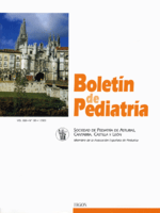Epilepsia benigna de la infancia con punta centrotemporal
C. Casas-Fernández , T. Rodríguez-Costa
Bol. Pediatr. 2003; 43 (183): 32 - 45
Se lleva a cabo un análisis del síndrome epiléptico más frecuente en la edad infantil, la Epilepsia Benigna de la Infancia con Punta Centrotemporal (EBICT), conocida desde hace casi cincuenta años en virtud de la escuela epileptológica francesa. Debe entenderse como el ejemplo genuino de las epilepsias parciales benignas y sirve para demostrar, asimismo, cómo no en todas las epilepsias deben emplearse fármacos antiepilépticos (FAEs), pudiendo incluso ser éstos un factor responsable del empeoramiento de las mismas, circunstancia que alcanza un máximo interés en éste síndrome. Se exponen los razonamientos que permiten plantear dudas sobre la aceptación del frecuentemente aceptado pronóstico benigno del síndrome, dado que es conocida la posible aparición de diferentes complicaciones evolutivas, que alcanzan su máxima expresividad en un déficit de rendimiento y aprendizaje escolar, junto con la aparición de crisis epilépticas de morfología inhabitual en el síndrome clásico, habiendo descrito Aicardi. Se revisan los criterios que configuran el fenotipo clínico y electroencefalográfico de éste síndrome epiléptico, cuya etiología idiopática ha permitido realizar investigaciones genéticas, iniciadas por Neubauer, con aparición posterior de diferentes hallazgos que permiten considerar la existencia de una heterogeneidad genética. Abstract An analysis is carried out on the most frequent syndrome in childhood age, Benign Childhood Epilepsy with Centrotemporal Spikes (BECT), known since almost fifty years ago because of the French epileptology school. It should be understood as the genuine example of partial benign epilepsies and also serve to demonstrate how antiepileptic drugs (AED) should not be used in all epilepsies, these even being the factor responsible for its aggravation, circumstance that reaches maximum interest in this syndrome. The reasons that make it possible to pose doubts on the acceptance of the frequently accepted benign prognosis of the syndrome are explained, given that the possible appearance of different evolutive complications are known. These reach their maximum expressivity in a performance and scholastic learning deficit, together with the appearance of epileptic episode of unusual morphology in the classic syndrome, it being described by Aicardi. A review is made of the criteria that shape the clinical and electroencephalographic phenotype of this epileptic syndrome, whose idiopathic etiology has made it possible to carry out genetic investigations, initiated by Neubauer, with the later appearance of different findings that permit the consideration of the existence of a genetic heterogeneity. Finally, the differential diagnosis is analyzed and a discussion is opened on the possible therapies, analyzing three aspects: a) the decision to initiate or delay prolonged prophylactic drug treatment, b) the evidence available regarding the efficacy of the different existing AEDs, c) the different recommendations on the length of the drug treatment, in the cases in which it has been initiated. It is concluded with the affirmation of being faced with an epileptic syndrome usually having good evolution, but in which the therapeutic measures on the one hand and the natural evolution on the other are not exempt of offering evolutive problems of a deeper neurologic significance and that should be well known to solve them, minimize them and even avoid them.
\N
\N
Artículo completo (PDF) (76 kb.)
- Neurología
